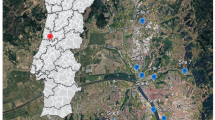Abstract
Only a few relatively wide barrier islands support shallow freshwater aquifers. Rare, swale wetlands occur on islands where fresh water inundates, at least seasonally, low-lying troughs between interior dunes. Swale wetlands are dominated by emergent vegetation and submerged aquatic vegetation in the deepest areas and by woody shrubs in more shallow areas. On southern Hatteras Island, wetland shrubs have progressively invaded open water areas over the past 40 years, suggesting a change in hydrologic regime. To determine the relationship between vegetation cover type and length of saturation, water-level fluctuations over time were analyzed to tie boundaries of six wetland cover types to the duration of soil saturation at 20-cm depth. We found that areas dominated by herbaceous vegetation had significantly longer flooding regimes than areas dominated by shrubs (85–95% vs. 12–69% of the growing season, respectively). Only 22–25 cm elevation differences were found to separate emergent marsh from the various shrub cover types, suggesting that lowering the mean water level via drainage has likely been responsible for shrub swamps replacing emergent marsh in swales. Although succession from open water to shrub swamp probably occurs naturally in the absence of drainage through the accumulation of organic matter, natural disturbances such as wildfire and storm-driven surges of saline water would have periodically re-set succession. Therefore, managing for long-term maintenance of freshwater swale wetlands on barrier island should include (1) eliminating or controlling drainage through constructed ditches, (2) eliminating man-made barriers that prevent the transport of saline water into ponds during hurricanes and nor’easters, and (3) initiating a prescribed burning program to mimic the historic, natural fire regime.
Similar content being viewed by others
Literature Cited
Anderson, Jr., W. P. 1999. The hydrology of Hatteras Island, North Carolina. Ph.D. Dissertation. North Carolina State University, Raleigh, NC, USA.
Anderson, W. P., Jr., D. G. Evans, and S. W. Snyder. 2000. The effects of Holocene barrier-island evolution on water-table elevations, Hatteras Island, North Carolina, USA. Hydrogeology Journal 8:390–404.
Art, H., F. H. Bormann, G. K. Voigt., and G. M. Woodwell. 1974. Barrier island forest ecosystem: role of meteorological inputs. Science 184:60–62.
Berman, M., G. Silberhorne, and C. Hershner. 1996. Analysis of temporal and spatial variations in vegetation communities for the Buxton Woods region of Cape Hatteras National Seashore. Center for Coastal Management and Policy, Virginia Institute of Marine Science, Gloucester Point, VA, USA.
Brown, C. W. 1983. A palynological study of peat layers from Jennette’s Sedge, North Carolina Outer Banks. M. A. Thesis, Smith College, Northhampton, MA, USA.
Davison, K. and S. P. Bratton. 1987. Disturbance and succession in Buxton Woods, Cape Hatteras, North Carolina. Castanea 52:166–179.
Gregory, J. D. and A. S. Morgan 1996. The effects of topography, rainfall, and ground-water withdrawal on the water table hydroperiod of Buxton Woods wetlands and adjacent uplands. Final Report to the USDI National Park Service, Cape Hatteras National Seashore and the North Carolina Division of Coastal Management, Releigh, NC, USA.
Health, R. C. 1988. Ground-water Resources of the Cape Hatteras Area of North Carolina. Report to Cape Hatteras Water Association, Inc., Buxton, NC, USA.
Leatherman, S. P. 1980. Barrier Islands Handbook, University of Marlyand Press, Colelge Park, MD, USA.
National Climatological Data Center. 1993. Local climatological data, Cape Hatteras, North Carolina. National Climatological Data Center, Asheville, NC, USA.
National Climatological Data Center. 1994. Local climatological data, Cape Hatteras, North Carolina. National Climatological Data Center, Asheville, NC, USA.
National Climatological Data Center. 1995. Local climatological data, Cape Hatteras, North Carolina. National Climatological Data Center, Asheville, NC, USA.
National Oceanic and Atmospheric Administration. 1995. 1994 climatological data annual summary for North Carolina. Asheville. NC, USA.
Odum, W. E. and J. W. Harvey. 1988. Barrier island interdunal freshwater wetlands. Association of Southern Biologists Bulletin 35:149–155.
Pyne, S. J. 1982. Fire in America: a Cultural History of Wildland and Rural Fire. Princeton University Press, Princeton, NJ, USA.
Riggs, S. R., W. J. Cleary, and S. W. Snyder. 1995. Influence of inherited geologic frameword on barrier island shoreface morphology and dynamics. Marine Geology 126:213–234.
Rheinhardt, R. D. and M. M. Brinson, 1997. Impact of water withdrawals on the vegetation of dune and swale communities of Cape Hatteras National Seashore, North Carolina. Technical Report to National Park Service Water Resources Branch, Colorado Springs, CO, USA.
Schafale, M. P. and A. S. Weakley. 1990. Classification of the Natural Communities of North Carolina: Third Approximation. North Carolina Natural Heritage Program, Division of Parks and Recreation. Raleigh, NC, USA.
Stalter, R. and W. E. Odum. 1993. Maritime communities. p. 117–163. In W. H. Martin, S. G. Boyce, and A. C. Echternacht (eds.). Biodiversity of the Southeastern United States, Lowland Terrestrial Communities. John Wiley, and Sons, Inc., New York, NY. USA.
Stevenson, J. D. 1989. An historical account of tropical cyclones that have impacted North Carolina since’ 1586. National Weather Service Office. Wilmington, NC, USA.
Tant, P. 1992. Soil survey of Dare County, North Carolina. United States Department of Agriculture, Soil Conservation Service. Washington DC, USA.
van der Valk, A. G. and C. B. Davis. 1978. The role of seed banks in the vegetation dynamics of prairie glacial wetlands. Ecology 59:322–335.
Author information
Authors and Affiliations
Corresponding author
Rights and permissions
About this article
Cite this article
Rheinhardt, R.D., Faser, K. Relationship between hydrology and zonation of freshwater swale wetlands on lower hatteras island, North Carolina, USA. Wetlands 21, 265–273 (2001). https://doi.org/10.1672/0277-5212(2001)021[0265:RBHAZO]2.0.CO;2
Received:
Revised:
Accepted:
Issue Date:
DOI: https://doi.org/10.1672/0277-5212(2001)021[0265:RBHAZO]2.0.CO;2




